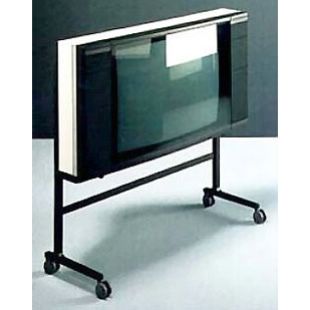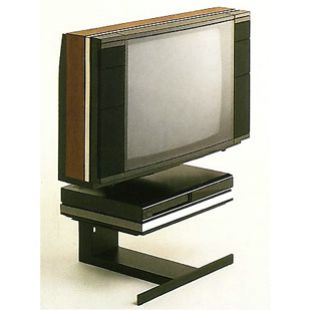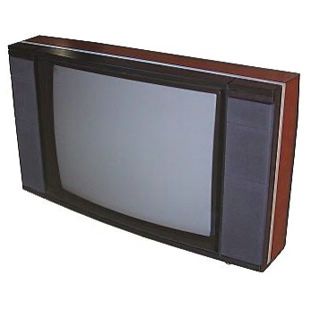BeoVision LX 2500
Manufactured: 1986 - 1988
Designer: David Lewis
Colours:
With its 63cm screen, Beovision LX2500 was the smallest member of the LX family in 1987. But no sacrifices were made in sound and picture excellence, nor was Beovision LX2500 ever caught out by new technical developments. No Master Control Link or additional speakers were required when installing a Beovision LX say, in the bedroom. The set came fully-equipped with a Master Control Link and all sound from the central music system could be fed through the TV speakers.
Installing a Beovision LX2500 in a study placed communication and information at your fingertips. Using a Beolink 1000 remote-control Terminal you could remote control and utilise all the features of the central system, including Teletext TV and video. And adding a home computer, video games and printer to the Beovision LX2500 used advanced electronics in a thoroughly practical way.
Beovisions LX2800 and LX2500 were identical in every detail except for the size of the picture screen.
Two television sets that were available but without Teletext, hi-fi sound or extra connection facilities were the Beovision L2800 and L2500. Other than these extra features, L2800 and L2500 were identical to the Beovisions LX2800 and LX2500.
Beovision Beovisions LX2800 and LX2500
Designed by David Lewis, the televisions were released in 1986. At the time, the LX range was special as it was the first type of television to include a contrast-screen and automatic picture control called VisionClear. It was controlled by a 'V Terminal', the forerunner of Beolink 1000. It was also the first TV range with an Audio/Aux Link and hi-fi speakers.
Beovision Beovisions LX2800 and LX2500 features:
Flat-square picture tube. Part of the VisionClear system which provides picture of studio quality
In-line self-converging picture tube, also part of the VisionClear system. Reduces the chance of inadvertent mixing of picture colours and ensures perfect pictures throughout the life of the TV.
Automatic Cut-off - yet another part of the VisionClear system. An electronic circuit which adjusts the colour balance 50 times every second. A patented Bang & Olufsen innovation which ensures that you get lifelike colours - automatic and operates all the time.
Contrast screen - the most visually outstanding part of the VisionClear system. A Bang & Olufsen screen which reduces the effect of incident light. This ensures clear colours and optimum contrast conditions even in bright light.
Automatic contrast control - the picture's contrast level is automatically adjusted to match the light levels in the room.
Remote-controlled channel tuning - included all relevant TV channels. You could use the buttons on the Beolink 1000 terminal to order the frequency of a specific TV channel and let the electronics take care of search, tuning and fine tuning. With the exception of the automation, it was the same search system that you used when you wished to find a new station on your radio.
AFC - A circuit that ensures perfect fine tuning and operated completely automatically.
Fine tuning - a manual feature which gave you access to sharp, stable pictures when reception conditions were poor or if the frequency of a signal deviated from standard settings e.g. in the case of cable TV, home computers etc. Fine tuning adjustments could of course, be stored in the memory.
2 x 15 watts sinus power output - the newly developed LX2800 and LX2500 speakers were based on the bass reflex system which gave the sound image extra depth and detail in hi-fi quality.
When there was a simulcast you could also send sound from the radio out through the speakers of Beovisions LX2800 and LX2500.
Stereo width adjustment 'increased' the distance between the speakers and gave a wider, richer sound image.
Enhanced mono broadcasts - the special stereo width circuit also improved the sound quality of mono broadcasts.
Extra hi-fi speakers - you could use the speakers on Beovision LX2800 or LX2500 as an extra pair of speakers for your hi-fi system as part of a Beolink® system.
Built-in Teletext decoder - the (then) new, 'flickerless' computer-controlled Teletext decoder (CCT) meant that you had the latest news right at hand as well as a whole host of information channels.
Computer-controlled Teletext (CCT) - had two memories so you could immediately 'leaf' up to two pages ahead on Teletext or back to the previous page. One touch and no waiting. Another memory store remembered up to four pages of Teletext information and provided immediate access to the TV listings or the complete Pools results, for example. This short-term memory was erased when the TV was returned to stand-by.
Three Teletext alphabets - if you received Teletext from a country with an alphabet that differed from your own, the Teletext alphabet switched over automatically.
Video recordings of Teletext subtitles - for the first time ever, it was possible to record the Teletext subtitles along with the TV programme itself. This was a big help for the hard-of-hearing
Completely stable and 'flickerless' picture from home computers and TV games.
Built-in clock - When Teletext was broadcast, you could bring the correct time on-screen, either for a few seconds or for as long as you liked.
A wealth of connection facilities
BeoVision LX 2500 Product Specifications
Beovision LX2500 Specifications
Types:
3441 (1986 - Nov 1987)
3741 (1986 - Dec 1987)
AUS, S-D-GB TXT 3456 (1986 - May 1987)
AUS, S-D-GB TXT 3756 (1986 - Sept 1987)
D-I-F TXT 3443 (1986 - Dec 1987)
D-I-F TXT, MULTI 3454 (1986 - Jan 1988)
D-I-F TXT, MULTI 3754 (1986 - Jan 1988)
D-I-GB TXT 3743 (1986 - Jan 1988)
F, MULTI 3452 (1986 - May 1988)
F, MULTI, Antiope 3453 (1986 - Sept 1986)
GB, S-D-GB TXT 3447 (1986 - Nov 1987)
GR 3760 (1986 - Feb 1988)
I, D-I-F TXT 3758 (1986 - May 1988)
Multi 3752 (1986 - May 1988)
Multi, Antiope 3753 (1986 - Dec 1987)
S-D-GB TXT 3442 (1986 - May 1988)
S-D-GB TXT 3742 (1986 - May 1988)
S-D-GB TXT 3747 (1986 - May 1988)
S-D-GB TXT, PAL/SECAM 3745 (1986 - Nov 1987)
S-D-GB TXT, PAL/SECAM 3765 (1986 - May 1987)
S-D-GB, PAL/SECAM 3445 (1986 - Jan 1988)
Picture tube size: 63cm
Visual picture size: 59cm
Speaker system, stereo: 2 pressure chamber cabinets
Woofer: 7.5cm
Treble: 5cm
Crossover frequency: 2500 Hz
Sound power output: 2 x 15 W / 8 ohms
Harmonic distortion: 0.5 %
Intermodulation: < 1 %
Frequency range: +/- 1.5 dB 25 - 20000 Hz
Power band width: 25 - 50000 Hz
Signal-to-noise ratio: > 50 dB: 20 - 15,000 Hz / 60 mV
Power supply: 220 - 240V / 50 - 60 Hz
Power consumption: 95 (75 - 165) watts
Stand-by: 3.5 W
Dimensions W x H x D: 78 x 48 x 42 cm
Weight: 37 kg
CTV system according to type
Channels VHF, UHF and S-channels
Stereo decoder according to type
Bilingual sound decoder according to type
Teletext decoder according to type
Connections: headphones output: Max 10.5V/200 ohms
External speakers: 8 ohms
A/V Socket 6p DIN Video output 1Vpp 75 ohms
AUX 3 Video input 1Vpp 75 ohms
Audio input 1V 47 kohms
Audio output 1V 1 kohm
A/V socket 21p Video output 1 Vpp 75 ohms
AUX 2 Video input 1 Vpp 75 ohms
RGB input 0.7 Vpp 75 ohms
Fast blanking 2V 75 ohms
Audio input 1V 47 kohms
Audio output 1V 1kohm
IR-codes pin8 2Vpp
Control voltage pin 8 >9.5 V
Tape output 1V 1 kohms
Amp. output 1V 1 kohms
Line Input 1V 47 kohms
Output 0-2V 1kohms (depending on volume level)
IR-input
Related Products
Created: 22nd December 2006
Modified: 3rd September 2007
Author Notes:







